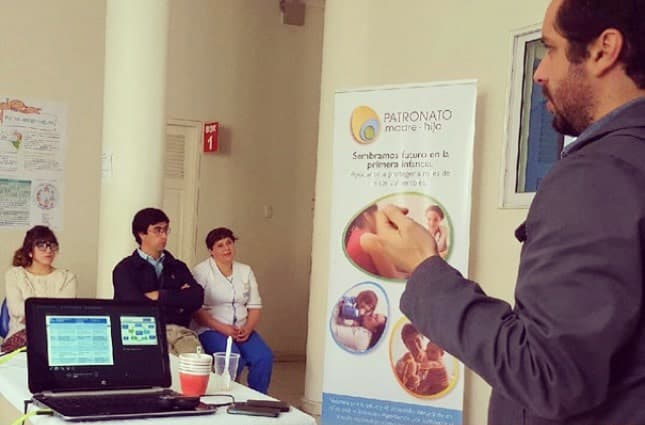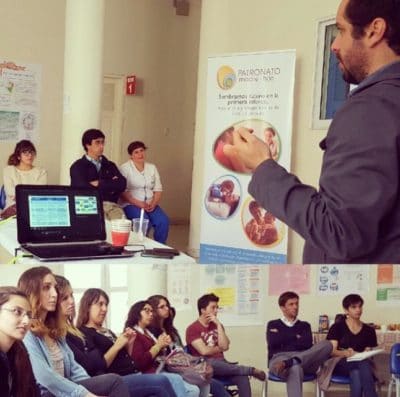Researchers at the Pontifical Catholic University of Chile have found that the number of conversational turns a child experiences at 18 months of age predicts social development and emotional health competencies at 30 months of age. The paper, co-authored by Esteban Gómez Muzzio and Katherine Strasser was published in the April 2021 issue of the journal Developmental Science. This marks the first peer-reviewed study to demonstrate a link between conversational turns and social development using LENA.
Many previous studies have drawn connections between the quantity of conversational turns in infancy and later linguistic and cognitive skills. For instance, LENA’s 2018 longitudinal study, published in the journal Pediatrics, showed that the conversations children experience as babies correlate 10 years later with their IQ, verbal comprehension, vocabulary, and other language skills.
Importantly, Gómez Muzzio’s and Strasser’s paper has taken a novel direction, determining that babies’ language environments predict their social and emotional skills one year later.
Gómez Muzzio said that this correlation between conversational turns and social growth seemed intuitive to him from the outset, that his own experiences as a father of three were revelatory.
“I was looking to my children when they were babies and started to think about how my responding to their vocalizations were connected to emotions,” he said. “I had an epiphany: Why are we not paying attention to turns in conversation, even before the children have developed vocabularies?”
Now, he says, they have the hard data to support that intuition.
The study on social development and emotional regulation
Taking a cue from that 2018 paper by LENA’s researchers and partners, which pinpointed the age range between 18 and 24 months as particularly predictive of cognitive development, the authors conducted their initial assessment of the study’s 50 participants at 18 months of age.
At that first assessment, the Functional Emotional Assessment Scale (FEAS) was used to measure each child’s emotional regulation, attachment, and emotional communication during a free-play session with their mother. The child’s language environment over a 10-hour period at home was also recorded and analyzed using LENA technology.
The same procedure took place at 30 months of age.
“There were so many people who wanted this research to be done, who gave their time freely,” Gómez Muzzio said. “That includes everyone from infant psychologists from Patronato Madre-Hijo NGO and América por la Infancia Foundation who volunteered their expertise to a taxi driver who helped retrieve the DLPs [digital language processors] from the families, who lived all over Santiago. It was a beautiful story of cooperation and solidarity.”
The results
The study found that emotional regulation, attachment, and emotional communication at 30 months of age were all significantly predicted by conversational turns at 18 months of age. This was after controlling for child sex, maternal warmth (using the affection domain of the Parenting Interactions with Children: Checklist of Observations Linked to Outcomes — PICCOLO), and social risk (using a cumulative index accounting for poverty, overcrowding, and other factors).
Very importantly, the authors also determined that the direction of causality went from conversational turns to social development and emotional health.
“I am excited by these results,” said Dr. Jill Gilkerson, LENA’s Chief Research and Evaluation Officer. “Although researchers have been aware of the link, this is the first paper to demonstrate this empirically using LENA. Their finding about directionality is particularly encouraging, as it suggests that intervention focused on early language interaction could directly influence social skills, in addition to cognitive and language benefits.”
While the authors say it’s likely that the quality of conversational turns has some bearing on emotional development, as previous studies have suggested, they especially emphasize the quantity and “temporal verbal synchrony” of those turns.
“Our results show that the sheer number of turns is relevant,” they write, “suggesting that talking with young babies, regardless of specific words or topics, can support the positive development of relational and emotional skills.”
Future directions
This point about quality versus quantity piques the authors’ interest for future investigation. They say they look forward to additional research that measures the content, not just the quantity, of conversational turns. They even suggest that “one of the reasons that positive parenting may contribute to social and emotional competencies could be that it promotes positive verbal patterns.”
With Gómez Muzzio’s expertise in emotional health and social growth and Strasser’s expertise in language development, the pair has offered a sound scientific foundation for future research on the long-term impacts of early talk on both social development and emotional regulation.
“These findings are some of the first to show predictive relations between quantitative aspects of the language input and children’s social competence,” Strasser said. “As such, I expect they will motivate more researchers to reflect on the precise nature of the contribution that the linguistic environment makes to other areas of child development.”
In fact, a follow-up study is already being designed, to be completed in collaboration with the organization Gómez Muzzio co-founded, Fundación América por la Infancia. This follow-up study will aim to assess the emotional competencies of the same children when they are 7 years old.
While the present study focused on parent interactions, Gómez Muzzio said he also plans to complete a larger study assessing interactions between children and teachers.
Updated findings
Gómez Muzzio presented findings from his follow-up study at the 2022 AG Bell Global Listening and Spoken Language Virtual Symposium. Among the questions this follow-up study asked: Do conversational turns in early childhood continue to predict social-emotional development several years down the road?
- Conversational turns at 30 months of age were shown to predict social-emotional competencies at 77 months of age, for socioemotional cognition, emotion regulation, and emotional communication.
- Conversational turns at 18 months of age did not show a relationship with socioemotional cognition or emotional communication at 77 months, but they did with emotion regulation. Gómez Muzzio suggested that a mediation effect may be at play, in which part of the effect of conversational turns at 18 months passes through conversational turns at 30 months.
- Maternal emotional warmth at 18 months showed a significant association with the same three measures of social-emotional competencies at 77 months.
This paper has been published in the journal Social Development.
Translating research into practice
As the co-founder and executive director of an organization dedicated to effecting a “paradigm shift” in childhood development throughout Latin America, Gómez Muzzio shares LENA’s drive to translate research into practical and impactful societal change. His organization’s program to promote positive parent-child relationships, called ODISEA (Opportunities for the development of Sensitive, Effective and Affective Interactions), is a multifaceted model for creating sustainable change.
“For me,” he said, “it doesn’t make sense to develop research that doesn’t have any effect in improving the life of real people, families, and communities.”
The authors of the paper think — and we here at LENA wholeheartedly agree — that it deserves greater attention moving forward. As do the ways that social, emotional, cognitive, and linguistic abilities interact.
“All the important aspects of long-term [this type of] development are present in these very powerful but concentrated moments when conversational turns take place,” Gómez Muzzio said. “It all starts in this small fragment of five seconds.”





